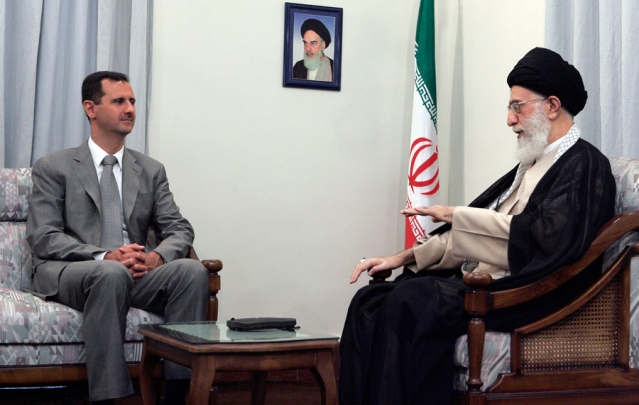How Many Iranians Have Been Killed In Airstrikes In Syria
جيروزاليم بوست: كم يبلغ عدد الإيرانيين الذين قُتلوا جراء الغارات الجوية الإسرائيلي على سوريا
Jerusalem Post/January 24/19
Since the beginning of the Syrian conflict in March 2011, Israel has admitted carrying out airstrikes.
After the recent round of airstrikes by Israel against Iranian targets in Syria, the London-based Syrian Observatory for Human Rights (SOHR) said that 12 Iranians were among those killed. This was after at least four sites maintained by the Iranian IRGC Quds Force members were struck. Nevertheless this is one of the few times that more than a handful of Iranians have been reported killed in airstrikes in Syria, despite what former chief of staff Gadi Eisenkot characterized recently as more than 1,000 airstrikes in Syria.
Since the beginning of the Syrian conflict in March 2011, Israel has admitted carrying out airstrikes. Over the years, the number of admitted airstrikes has grown. In many incidents, Syrian media have blamed Israel for airstrikes. Only in a smattering of those attacks have Iranians been reported killed.
In the early days of the Syrian conflict, these incidents were very rare. In mid-February 2013, an IRGC commander named Hussam Hush Nawis, who also went by the nom du guerre Hassan Shateri, was killed in Jamraya 5 km. from Damascus. A Syrian rebel group blamed Israel for the attack, but Iran’s Mehr news pointed the finger at “Israeli agents,” not an airstrike. On January 18, 2015, IRGC Gen. Mohammed Ali Allahdadi was killed in an airstrike near the Golan Heights along with five other Iranians and a half-dozen Hezbollah fighters.
SOHR has become one of the main sources for identifying Iranians killed in Syria but its fatality statistics are often unclear. For instance, one report indicated nine Iranians were killed in July 2018 airstrikes, one of which targeted a warehouse near Aleppo. A separate report said nine Syrian soldiers were killed there, while a third report indicated three “others” were killed, according to SOHR.
The “others” might have been Iranian. In late May, another report claimed nine Iranians were killed near Homs, but Iran’s media denied that they had lost any personnel. During a May airstrike near Kiswah, another eight Iranians were reported killed. SOHR said 15 had been killed in total.
In an April 9 attack on drone hangars at the Tiyas Military Airbase near Homs, also known as the T-4 Airbase, seven IRGC members were reported killed, including an officer named Mehdi Dehghan. Initially, Fars News reported only three Iranian were killed. Several were named to begin with, before details were retracted in Iranian sources. This information appeared to be confirmed in Iranian media before some of the details were deleted. An official was quoted in The New York Times saying that this was the first time “live Iranian” targets were struck. 11 more Iranians may have been killed in a late April attack near Hama. In December, an airstrike near Damascus was said to have killed 12 Iranians. SOHR also reported airstrikes in September and November 2017 that may have killed Iranians. The reports were not always clear on who the casualties were, even when IRGC sites were targeted. The total numbers since 2012 add up to between 60 and 80 Iranians killed in airstrikes in Syria, if the estimates provided by various sources are credible.
In the fog of war, reports of casualties are often either biased or contradictory. For instance, while Syrian rebel sources may inflate the number of Iranian casualties, Iranian media seeks to play down the numbers. Denial also dovetails with the Syrian regime narrative, which often claims that regime air defenses intercepted incoming missiles. Soldiers don’t die in attacks which supposedly were foiled, according to logic of the Syrian regime and its Iranian ally.
Unlike some of the “martyrs” Iran seeks to honor in the war against ISIS or other conflicts in Iraq and Syria, those killed in the airstrikes are seen as a humiliation. If Iran admitted that it lost scores of men in Syria and didn’t retaliate, it would appear weak. The fog of war benefits Iran in this way. It also benefits the Syrian regime, which doesn’t have to admit that its air defense is unable to defend Iranian assets in Syria.
The question of why so few Iranians have been reported killed speaks to the precise nature of the airstrikes that have been revealed. For instance, in the January 20-21 airstrikes against four IRGC targets and several Syrian air defense targets, very few personnel were harmed. Yet the exact targets of most of the hundreds of airstrikes that officials have mentioned in interviews are largely unknown. When they have been revealed, such as the warehouse in Latakia struck in September, they consist of sites such as warehouses that don’t include personnel. This has also reduced casualties. Gadi Eisenkot told The Times in mid-January that Israel has struck thousands of targets. With only a few dozen reported killed in those strikes, it appears the airstrikes have among the lowest number of casualties per airstrike of any war in recent history.




















